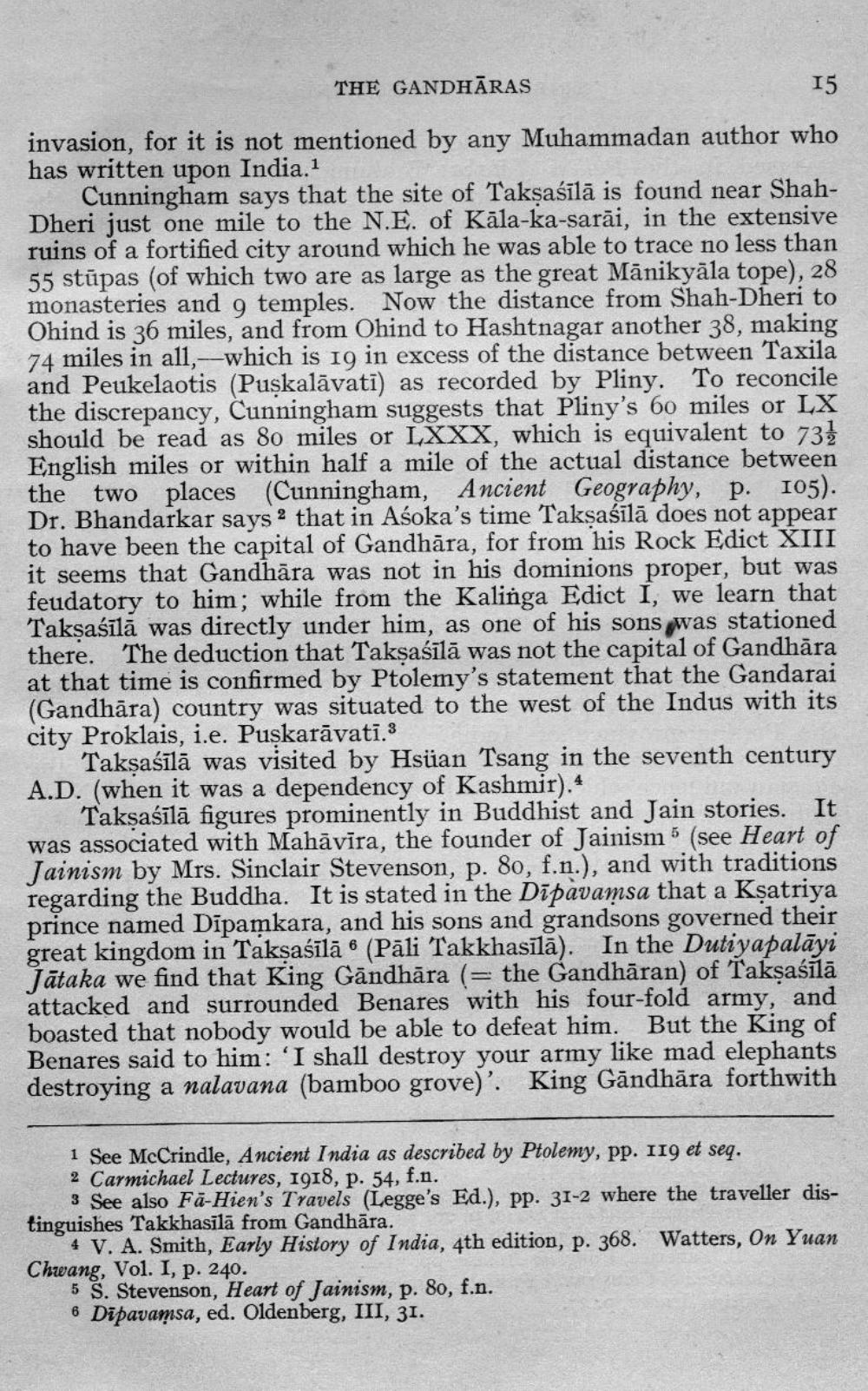________________
THE GANDHĀRAS
15
invasion, for it is not mentioned by any Muhammadan author who has written upon India.1
Cunningham says that the site of Takṣaśīlā is found near ShahDheri just one mile to the N.E. of Kala-ka-sarai, in the extensive ruins of a fortified city around which he was able to trace no less than 55 stūpas (of which two are as large as the great Manikyala tope), 28 monasteries and 9 temples. Now the distance from Shah-Dheri to Ohind is 36 miles, and from Ohind to Hashtnagar another 38, making 74 miles in all,--which is 19 in excess of the distance between Taxila and Peukelaotis (Puskalavati) as recorded by Pliny. To reconcile the discrepancy, Cunningham suggests that Pliny's 60 miles or LX should be read as 80 miles or LXXX, which is equivalent to 731 English miles or within half a mile of the actual distance between the two places (Cunningham, Ancient Geography, p. 105). Dr. Bhandarkar says 2 that in Aśoka's time Takṣaśīlā does not appear to have been the capital of Gandhara, for from his Rock Edict XIII it seems that Gandhara was not in his dominions proper, but was feudatory to him; while from the Kalinga Edict I, we learn that Takṣaśīlā was directly under him, as one of his sons was stationed there. The deduction that Takṣaśīlā was not the capital of Gandhara at that time is confirmed by Ptolemy's statement that the Gandarai (Gandhāra) country was situated to the west of the Indus with its city Proklais, i.e. Puskarāvati.3
Takṣaśīlā was visited by Hsüan Tsang in the seventh century A.D. (when it was a dependency of Kashmir).*
Takṣaśīlā figures prominently in Buddhist and Jain stories. It was associated with Mahavira, the founder of Jainism 5 (see Heart of Jainism by Mrs. Sinclair Stevenson, p. 80, f.n.), and with traditions regarding the Buddha. It is stated in the Dipavamsa that a Kṣatriya prince named Dipamkara, and his sons and grandsons governed their great kingdom in Takṣaśīlā (Pāli Takkhasīlā). In the Dutiyapalayi Jātaka we find that King Gandhara (= the Gandharan) of Takṣaśīlā attacked and surrounded Benares with his four-fold army, and boasted that nobody would be able to defeat him. But the King of Benares said to him: 'I shall destroy your army like mad elephants destroying a nalavana (bamboo grove)'. King Gandhara forthwith
6
1 See McCrindle, Ancient India as described by Ptolemy, pp. 119 et seq. 2 Carmichael Lectures, 1918, p. 54, f.n.
3 See also Fa-Hien's Travels (Legge's Ed.), pp. 31-2 where the traveller distinguishes Takkhasilä from Gandhāra.
4 V. A. Smith, Early History of India, 4th edition, p. 368. Watters, On Yuan Chwang, Vol. I, p. 240.
5 S. Stevenson, Heart of Jainism, p. 80, f.n.
6 Dipavamsa, ed. Oldenberg, III, 31.




